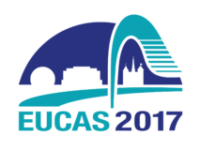Speakers
Description
Abstract
This course addresses the current state and prospects of high temperature superconductor (HTS) technology. The scope is to illustrate the close synergetic relationship between the development of a deeper understanding of the material properties and the progresses in the conductor technology, with a focus on high field magnet applications. The course is organized in four parts:
1) An introduction to high temperature superconductivity;
2) The basics of HTS conductor fabrication (REBCO coated conductors, BSCCO-2223 tapes and BSCCO-2212 wires), including latest developments to improve performance;
3) An overview of the electromagnetic, electromechanical and thermophysical properties of the conductors;
4) Critical issues and innovative design concepts for the HTS-based magnet with an overview of noteworthy ongoing magnet projects.
Speaker Bio.
Carmine Senatore.
Prof. Carmine Senatore was appointed head of the Group of Applied Superconductivity at the University of Geneva, Switzerland, in 2010. He received his MSc degree cum laude in Physics in 2000 and his doctoral degree in 2004 at the University of Salerno, Italy. His formation as solid state physicist was focused on the vortex dynamics in high-Tc
superconductors. Presently, his primary activity is on superconducting materials for largescale applications. The research of Prof. Senatore is driven by the challenge to understand and control the basic properties required for the practical implementation of superconductors. This includes all material aspects that play a role in tuning the superconductor properties aswell as innovative approaches to the processing of superconducting wires and tapes. His activities focus on the development of both low- and high-Tc superconductors for applications in various fields, from the high field magnets for NMR/MRI systems and particle accelerators to the emerging applications in the electric power infrastructure. Recently, his group has developed and tested in collaboration with Bruker BioSpin a superconducting coil able to generate a magnetic field of 25 Tesla. Senatore also takes part in the CERN study forthe next generation accelerator magnets in view of a 100 TeV energy-frontier hadron collider.
Matteo Alessandrini
Matteo Alessandrini is a Group Leader in the R&D department of NMR magnets of Bruker BioSpin AG in Switzerland. He has 10+ yrs of experience in the field of MRI/NMR magnets and superconducting wire technologies. He holds a Master in Mechanical Engineering from University of Bologna and a Master in Space Studies from ISU, Strasbourg. He received his PhD in 2007 in the group of Dr.Salama at UH-TcSUH under the interdisciplinary program of Materials Engineering working in collaboration with NASA-JSC and AdAstraRocket co. on a thesis about MgB2 wires for weight-critical applications. He was an intern at LASA-Milan and at LBNL. Before joining Bruker, Dr.Alessandrini worked on MRI magnet technologies at GE-GRC in Niskayuna, NY.
Kenneth Günter
Kenneth Günter is a R&D scientist at Bruker BioSpin developing superconducting magnet systems. He received his Ph.D. degree in experimental Physics from the Swiss Federal Institute of Technology (ETH) in Zurich for his work in the domain of quantum optics and cold atomic gases. From 2008 to 2011 he worked as a Marie Curie researcher at Ecole Normale Supérieure in Paris, before returning to Switzerland and joining Bruker BioSpin. Kenneth leads various R&D projects and focuses in particular on technology development and magnet design of devices using high-Tc superconductors, mainly for magnetic resonance applications.




